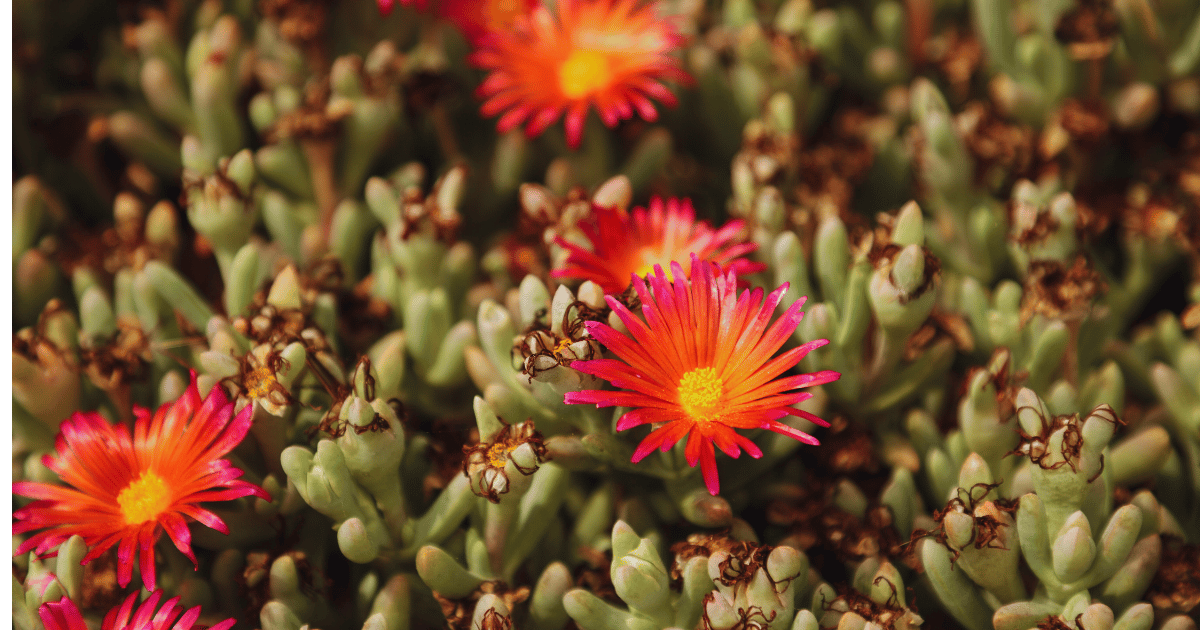Ice Plant succulents are a vibrant addition to any garden, known for their dazzling blooms and hardy nature. Native to South Africa, these resilient plants thrive in challenging conditions, making them a top choice for gardeners seeking low-maintenance beauty. With their thick, fleshy leaves and vibrant flowers in shades of pink, purple, yellow, and white, Ice Plants create a stunning display that lasts throughout the growing season.
What makes Ice Plant succulents particularly appealing is their adaptability. They flourish in full sun, require minimal watering, and thrive in poor, well-draining soils. Their spreading habit makes them ideal for ground cover, rock gardens, and erosion control, adding color and texture to landscapes. Additionally, these succulents are easy to propagate, ensuring that your garden can continue to flourish year after year. Whether you’re an experienced gardener or just starting, Ice Plant succulents offer a simple way to achieve a beautiful, low-maintenance landscape.
About Ice Plant

The Ice Plant, a succulent from the Aizoaceae family, is celebrated for its vibrant, daisy-like flowers and thick, fleshy leaves. It belongs primarily to the genera Delosperma and Mesembryanthemum, both known for their ability to thrive in arid conditions. Originating from South Africa, Ice Plants have adapted to survive in harsh, sun-drenched environments with minimal water, making them ideal for drought-tolerant gardening.
The name “Ice Plant” comes from the shimmering, crystal-like structures on the leaves of some species, which resemble ice crystals and help the plant retain moisture. Over time, these succulents have spread beyond their native habitat, becoming popular in gardens worldwide for their resilience and striking appearance. Their ability to cover large areas with vibrant blooms has made them a favorite for ground cover, rock gardens, and erosion control, especially in regions with hot, dry climates.
Unique Characteristics

Ice Plant succulents are distinguished by their thick, fleshy leaves, which store water and give the plant its characteristic drought resistance. These leaves often appear in shades of green, sometimes with a slight reddish or silvery hue, and are covered with tiny, glistening papillae that resemble ice crystals, giving the plant its name.
The vibrant flowers of the Ice Plant are another standout feature. Blooming in a wide range of colors, including pink, purple, yellow, and white, these daisy-like flowers open in the sunlight and close at night, creating a dynamic, colorful display throughout the growing season. The blooms often cover the plant so densely that the foliage is barely visible, transforming landscapes into vibrant carpets of color.
Ice Plants are exceptionally adaptable, thriving in drought-prone areas and withstanding extreme weather conditions, including intense heat and poor soil quality. Their spreading habit makes them an excellent choice for ground cover, as they form dense mats that help to stabilize soil and prevent erosion, particularly on slopes and in rock gardens.
Benefits of planting Ice plant
Ice Plant succulents offer several benefits that make them a popular choice for gardeners and landscapers:
- Drought Tolerance: Ice Plants are exceptionally drought-tolerant, requiring minimal water once established. This makes them ideal for water-wise gardening, especially in regions prone to drought or where water conservation is a priority.
- Low Maintenance: These succulents require little care, thriving in poor, well-draining soils and withstanding neglect. They need minimal fertilization and are generally pest-resistant, making them an easy option for busy gardeners.
- Vibrant Blooms: Ice Plants produce a profusion of bright, daisy-like flowers in various colors, including pink, purple, yellow, and white. These blooms add vibrant color to gardens and landscapes throughout the growing season.
- Ground Cover: Ice Plants are excellent for ground cover with their spreading growth habit. They form dense mats that help suppress weeds, retain soil moisture, and stabilize soil on slopes, reducing erosion.
- Heat and Cold Tolerance: Many Ice Plant varieties can withstand extreme temperatures, from intense heat to frost, making them versatile for different climates.
- Erosion Control: Ice Plants effectively prevent soil erosion, particularly on slopes and hillsides. Their extensive root systems anchor the soil, reducing the risk of landslides or soil displacement.
- Attracts Pollinators: The bright flowers of Ice Plants attract pollinators such as bees and butterflies, contributing to a healthy and biodiverse garden ecosystem.
- Versatility in Landscaping: Ice Plants are suitable for various landscaping uses, including rock gardens, container planting, xeriscaping, and borders. Their adaptability and aesthetic appeal make them versatile for different garden designs.
- Easy Propagation: Ice Plants can be easily propagated from cuttings or seeds, allowing gardeners to expand their plantings without significant cost or effort.
Types of Ice Plant Succulents
Delosperma Cooper
- Description: Delosperma Cooperi, often known as the “Hardy Ice Plant,” is one of the most popular varieties of Ice Plants. It is prized for its vibrant purple-pink flowers, which bloom profusely from late spring through fall. The blooms are striking against the plant’s green, succulent foliage, creating a stunning contrast that adds visual interest to any garden.
- Ideal Growing Conditions and Uses in Landscaping: This variety thrives in full sun and well-draining soil, making it an excellent choice for xeriscaping and drought-tolerant gardens. Delosperma cooperi is commonly used as ground cover due to its spreading habit, and it works well in rock gardens, along borders, or cascading over walls. It is also well-suited for container planting, where its bright blooms can be enjoyed up close.
Delosperma Nubigenum
- Description: Delosperma Nubigenum is a cold-hardy Ice Plant variety, distinguished by its cheerful yellow flowers. This plant is one of the few Ice Plants that can tolerate colder climates, surviving in temperatures as low as -20°F (-29°C). The bright yellow blooms appear in early spring and continue into summer, providing a burst of color when many other plants are still dormant.
- Uses in Rock Gardens and as Ground Cover: Delosperma Nubigenum is ideal for rock gardens, where its low-growing, spreading habit allows it to fill in gaps between rocks and other plants. It also makes an adequate ground cover, particularly in areas prone to cold winters, as it can withstand freezing temperatures and quickly rebounds in spring. Its ability to thrive in hot, dry summers and cold winters makes it a versatile addition to various landscapes.
Mesembryanthemum Crystallinum (Common Ice Plant)
- Description: Mesembryanthemum Crystallinum, commonly known as the Common Ice Plant, is famous for its unique, crystalline appearance. The leaves and stems of this plant are covered with tiny, glistening cells that resemble ice crystals, giving it a frosty, shimmering look even in the heat of summer. This visual effect, combined with its white or pink flowers, makes it a standout in ornamental gardening.
- Uses in Ornamental Gardening: The Common Ice Plant is often used as an ornamental ground cover or in container gardens, where its striking appearance can be showcased. Its ability to tolerate poor soil and harsh sunlight makes it a resilient choice for decorative garden beds, borders, or accent pieces. Its unique texture and appearance make it a popular choice for adding visual interest to succulent gardens and coastal landscapes.
Read to know more: Succulent Candles: A Blend of Nature and Tranquility
Ogre Ear Succulent:The ultimate Growing and Caring Guide
Growing and Caring for Ice Plant Succulents
Ideal Growing Conditions
- Sunlight: Ice Plants thrive in full sun, requiring at least 6 to 8 hours of direct sunlight daily. Total sun exposure ensures these succulents produce abundant, vibrant blooms and maintain their compact, low-growing habit.
- Soil: These succulents prefer well-draining sandy or gravelly soil. The key is to avoid heavy, clay-rich soils that retain water, as Ice Plants are highly susceptible to root rot in soggy conditions. Amending the soil with sand, grit, or perlite can improve drainage.
- Watering: Ice Plants have minimal watering needs, making them perfect for dry, drought-prone regions. Watering them sparingly is crucial, allowing the soil to dry out completely between waterings. Overwatering should be avoided, especially in cooler weather when the plants are more dormant.
Propagation Methods
- Overview of Seed Propagation: Propagating Ice Plants from seeds is a straightforward process, though it requires patience. Seeds should be sown in a well-draining seed mix, lightly covered, and kept in a warm, sunny location. Germination typically occurs within a few weeks.
- Steps for Propagating Through Cuttings: Propagating Ice Plants through cuttings is a quicker and more reliable method. To propagate, cut a healthy stem from the parent plant, allow it to dry and callous over for a few days, then plant it in well-draining soil. Keep the cutting lightly moist until roots develop.
- Tips for Ensuring Successful Propagation: When propagating, ensure the cuttings are taken from healthy, non-flowering stems. Provide plenty of sunlight and avoid overwatering. Rooting hormone can encourage faster root development, but it’s not essential.
Common Problems and Solutions
- Pests: Ice Plants can occasionally be affected by pests such as aphids and mealybugs. These pests can be controlled by regularly inspecting the plants and treating infestations with insecticidal soap or neem oil.
- Diseases: The most common issue with Ice Plants is root rot, caused by overwatering or poor drainage. Ensuring the soil is well-draining and the plants are not overwatered is critical to preventing this problem. Fungal infections can also occur, particularly in humid conditions; these can be treated with fungicides or by improving air circulation around the plants.
- Environmental Challenges: Ice Plants are sensitive to frost, which can damage or kill them. In cooler climates, it’s essential to plant them in a location that offers some protection from frost, such as near a south-facing wall. In extreme heat, they may need some afternoon shade to prevent scorching.
Uses in Landscaping
Ground Cover
- Benefits of Using Ice Plants as a Ground Cover in Xeriscaping: Ice Plants are ideal for xeriscaping due to their low water requirements and ability to cover large areas. Their spreading habit helps suppress weeds, conserve soil moisture, and reduce erosion, making them a practical and attractive ground cover for dry landscapes.
- Examples of Landscaping Designs Incorporating Ice Plants: Ice Plants can create vibrant, colorful carpets in rock gardens, along pathways, or in large, open areas. They can also be combined with other drought-tolerant plants, such as sedums and agaves, to create a diverse, water-efficient garden.
Container Gardening
- Tips for Growing Ice Plants in Pots or Containers: When growing Ice Plants in containers, choose pots with good drainage and use a well-draining cactus or succulent mix. Position the containers in full sun and water sparingly. Containers allow easy movement to protect the plants from frost or intense heat.
- Advantages of Container Gardening for Small Spaces: Container gardening is ideal for small spaces such as patios, balconies, or small urban gardens. It allows gardeners to enjoy the beauty of Ice Plants without needing a large garden area. Containers also make it easier to control soil conditions and manage the plants’ growth.
Erosion Control
- Ice Plant’s Role in Preventing Soil Erosion on Slopes and Hillsides: Ice Plants effectively prevent soil erosion due to their extensive root systems, which anchor the soil in place. They are often used on slopes, hillsides, and embankments to stabilize the soil and prevent landslides, especially in areas prone to heavy rainfall or wind erosion.
- Examples of Successful Erosion Control Projects: Ice Plants have been used successfully in various erosion control projects, particularly in coastal and arid regions. Their ability to thrive in poor soil conditions and withstand harsh environments makes them an excellent choice for stabilizing challenging landscapes. Examples include using Ice Plants along highways, on coastal dunes, and in large-scale xeriscaping projects designed to reduce soil erosion and water usage.
How to Decorate Your Home with Ice Plants

- Create a Succulent Centerpiece
- Arrange Ice Plants in a shallow, decorative tray or planter to create a vibrant centerpiece for your dining or coffee table.
- Combine different varieties for a mix of colors and textures.
- Use Hanging Planters
- Plant Ice Plants in hanging baskets or wall-mounted planters to add greenery to vertical spaces.
- Their trailing habit makes them perfect for cascading displays.
- Design a Windowsill Garden
- Place small pots of Ice Plants along sunny windowsills to brighten up your kitchen or living room.
- Choose colorful varieties to add a pop of color to the room.
- Decorate with Terrariums
- Create mini desert landscapes by placing Ice Plants in glass terrariums with sand, pebbles, and other succulents.
- Terrariums make stylish additions to desks, shelves, or mantels.
- Accent Shelves and Bookcases
- Add small Ice Plant arrangements to shelves or bookcases to introduce natural elements into your décor.
- Use decorative pots or unique containers to enhance the aesthetic.
- Outdoor Patio Decor
- Place Ice Plants in pots or containers around your patio or balcony for a low-maintenance, colorful display.
- Mix with other succulents or drought-tolerant plants for a cohesive look.
- Incorporate into Tabletop Decor
- Use Ice Plants in decorative pots as part of your tabletop decor for special occasions or everyday use.
- They can be paired with candles, stones, or other natural elements for a rustic or bohemian style.
- Frame Windows with Planters
- Position Ice Plants in long, narrow planters along the base of windows to create a natural frame of greenery.
- This works well in both indoor and outdoor settings.
- Design a Succulent Wall
- Create a living wall by planting Ice Plants in a vertical garden frame.
- This can be an eye-catching feature in a living room, kitchen, or outdoor space.
- Decorate with Seasonal Themes
- Change the display of your Ice Plants according to the seasons or holidays.
- Use festive pots or combine them with seasonal decorations like fall pumpkins or winter ornaments.
Read our article to know: The Top 11 Succulents for Bathroom: Bringing Nature Indoors
FAQ: Ice Plant Succulents
1. What are Ice Plants?
- Ice Plants are succulent plants known for their fleshy leaves and vibrant, daisy-like flowers. They are native to arid regions like South Africa and are prized for their drought tolerance and striking appearance.
2. How much sunlight do Ice Plants need?
- Ice Plants prefer full sun and need at least 6 to 8 hours of direct sunlight each day to thrive and produce abundant blooms.
3. What type of soil is best for Ice Plants?
- Ice Plants thrive in well-draining soil. A mix of sandy or gravelly soil is ideal. Avoid heavy, clay-rich soils that can lead to root rot.
4. How often should I water Ice Plants?
- Ice Plants require minimal watering. Water them sparingly, allowing the soil to dry out completely between waterings. Overwatering can lead to root rot.
5. How do I propagate Ice Plants?
- Ice Plants can be propagated from seeds or cuttings. For seeds, sow in a well-draining mix and keep warm. For cuttings, allow the cut end to callous before planting in well-draining soil. Both methods require minimal watering until roots develop.
6. What pests affect Ice Plants?
- Common pests include aphids and mealybugs. Control them with insecticidal soap or neem oil. Regular inspection and prompt treatment can help manage infestations.
7. What diseases should I watch out for?
- Ice Plants can suffer from root rot in humid conditions due to overwatering and fungal infections. To prevent these issues, ensure good drainage and avoid overwatering.
8. Can Ice Plants tolerate cold temperatures?
- Some Ice Plant varieties, like Delosperma Nubigenum, are cold-hardy and can tolerate frost. However, many Ice Plants are sensitive to freezing temperatures and protect in colder climates.
9. How can I use Ice Plants in home decor?
- Ice Plants can be used as table centerpieces, in hanging planters, on windowsills, in terrariums, and as part of a succulent wall. They add color and texture to various indoor and outdoor settings.
10. What are the benefits of using Ice Plants in landscaping?
- Ice Plants are excellent for ground cover, erosion control, and xeriscaping. They provide vibrant color, reduce soil erosion, and require minimal water and maintenance.
11. Are Ice Plants suitable for container gardening?
- Yes, Ice Plants are well-suited for container gardening. Use pots with good drainage and a well-draining soil mix. They are ideal for patios, balconies, and small spaces.
12. How do I prevent Ice Plants from becoming invasive?
- To prevent Ice Plants from becoming invasive, monitor their spread and trim any overgrowth. In areas where they may become problematic, consider using them in controlled environments like containers.
Conclusion
Ice Plant succulents offer a vibrant, low-maintenance option for indoor and outdoor spaces. Their striking blooms and drought tolerance make them ideal for landscaping, from ground cover to container gardening. With minimal care requirements and adaptability to harsh conditions, Ice Plants are versatile for adding color and texture to your home and garden. Embrace the beauty and resilience of Ice Plants to enhance your landscape while enjoying their effortless charm and practical benefits.







